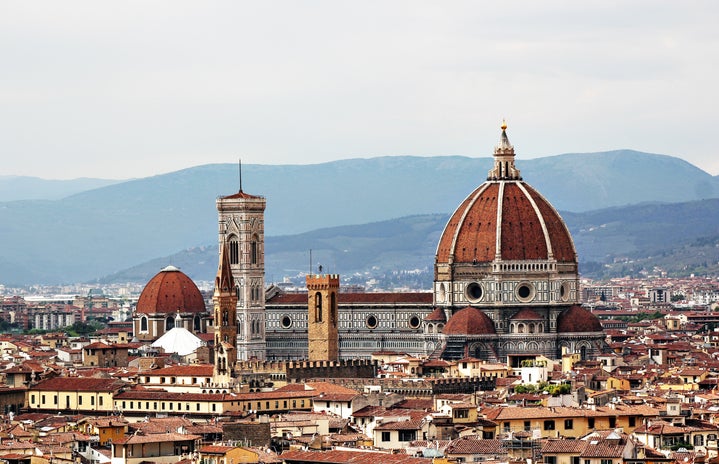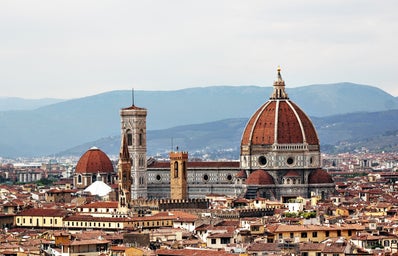In June of 2018 I became a TEFL-certified teacher and commenced my position as a submersion English instructor in the Northeastern Italian city of Treviso. I moved around a lot during the program that I was working for. In five months I stayed with six host families, taught four classes, and traveled as far North as the Austrian border and as far south as Palermo. This was my fourth time in Italy after studying the language for my entire life.
One of my favorite class activities was a cultural comparison that I did with my older students to start a conversation in English all about the similarities and differences between Italy and America. When I requested defining factors of each nation I always got some curveball answers, but for the most part what they came up with was similar. Hamburgers, Donald Trump, and Macklemore (who was rather famous in Italy in 2018) were what they could name for the United States, and they defined Italy with pizza, football (soccer), and always, the mafia.
I never really considered that the mafia may still be active in Italy today. None of my professors or classmates discussed the matter unless it was to mimic characters in the film The Godfather. By now I’ve learned that although the mafia may no longer be detonating TNT on highways or killing journalists, they have morphed into another form of sociopolitical dominance that is only strengthened by crisis.
It is now May of 2020. Coronavirus has taken the world into its malicious grasp with over three million confirmed cases of the virus. Italy is at the forefront of infection and has been in stringent lockdown for over a month. The country has over 200,000 confirmed cases, however an Italian health official stated his belief that due to the rate of asymptomatic carriers and people with minor infections who do not get tested, between 5 and 20 million people of their population of 60.36 million may have been infected.
In Treviso, I lived with two English roommates in a vacant apartment below my host family’s penthouse. Every night the three of us joined them for dinner on their terrace above the rust-colored roofs of Treviso. We’d eat pasta first as you did in Italy, il primo piatto. Il secondo was different for each family that I stayed with. Here, it was typically a plate with cheese that my host mom had curated from France paired with honey, or melon and figs wrapped in prosciutto. Dessert was sorbet, gelato, or fresh fruit with hand whipped cream.
My host dad spoke no English, so I acted as the translator between him and my roommates as I was the only one fluent in both languages.
“The mafia used to have complete control over Treviso back in the 1970’s,” said our host dad over dinner one night, “the government got rid of them, but they still have a heavy presence in the South.”
“Will I be okay if I go to the South later this Summer?” I asked.
“You’ll be fine,” he responded, “they don’t kill much anymore, and never target tourists.” I was relieved, kind of. I had plans to go to Sicily in a month, and decided to learn more about the mafia’s presence down there.
The Sicilian Mafia, also known as Cosa Nostra (translation: our thing), or simply the Mafia dates back to the 19th century, but the mafia of today was widely formed post-World War II. The term “mafia” comes from a Sicilian-Arabic proverb that roughly translates to “acting as protector against the arrogance of the powerful.” In Italy, there are four known organized crime groups and Cosa Nostra (the Sicilian Mafia) should not be confused with other groups like Camorra or ‘Ndrangheta, although they are now widely allied and all fall within the term “Mafia”.
There is still a lot of unknown about Cosa Nostra. The punishment for providing information about the organization to the outside is death to the informant and often their family as well. This code of silence among mafiosi (mafia men) is known as omertà. Much of the information that is known comes from the informant Tomasso Buscetta, a mafioso who gave testimony about the organization back in 1984.
In Cosa Nostra, there are about 100 families. Families need no blood relation. These families are known as cosche, or clans. Each clan is sovereign over a territory, and among these clans there are mafia commissions. Commissions are not governing mafia bodies, they have little power aside from regulating violence. Within each clan, there are a set of roles. The clan is led by the boss, or the capofamiglia. He is aided by the underboss or sotto capo, and this pair is supervised by advisers (consigliere). Under the boss’ command are groups known as decina who serve as soldiers for the clan, and each decina is led by a capodecina. Associates are not a part of the clan, but they work for and aid it. Mafiosi consider them to be nothing more than a tool; simply business partners who get extorted. Mafiosi of equal rank refer to each other as compare (comrade) and inferiors call their superiors padrino, which translates to godfather. All members of Cosa Nostra must be Sicilian men, and in order to become initiated into the organization they must commit murder.
Cosa Nostra is involved with a handful of organized crimes, but they primarily offer protection rackets to businesses and corporations in Sicily. This gains them foothold in the Italian economy. A recent report estimated that Cosa Nostra cost Sicily over ten billion euro a year due to these protection rackets. The same report estimated that nearly 70% of Sicilian businesses paid protection money to Cosa Nostra. Sometimes, the payment requested isn’t money. The Sicilian Mafia instead asks their associates to commit a crime for them. Mafiosi are forbidden from kidnapping or theft, and therefore may force an associate to do so. Cosa Nostra is involved in criminal activities beyond this. Politicians often ask mafiosi for electoral support which tends to lead to vote buying. In exchange for vote buying, mafiosi coerce politicians into favors such as giving contracts or sabotaging police activity. The Sicilian Mafia is also involved in raising money for smugglers, activity in drug cartels, and money laundering.
On March 9th of 2020, the Italian Prime Minister implemented a national quarantine of Italy. My first thought was to reach out to my host families who were there to see how they were doing. My host sister from Treviso sent me a picture from that terrace, showing that the streets were completely empty. The Italian Prime Minister declared that this was the worst crisis that Italy has experienced since World War II.
“Treviso was destroyed in World War II,” said my host dad over dinner one night.
“How so?” asked my roommate.
“The city was heavily bombed by the allies. Hardly any of the buildings made it. They never really bombed the important cultural cities like Roma and Firenze because they knew they’d be destroying priceless art and architecture. Treviso was an important Northern city, but not in that way. Everything was destroyed. Much of what you see is recreations of old architecture, reconstructed with money from the Americani.”
I vaguely remember learning about the Marshall Plan in 11th grade AP European History, but this was the first time I had ever really considered what the world would look like without it. For one, I would not be sitting on a terrace in Treviso right now.
My apartment in Treviso was used by my host family as an archive of their history. In my bedroom I had a slightly unsettling collection of authentic oil paintings dating back to the Renaissance. Every night while I slept, the eyes of la Madonna and various noblemen stared back at me. On some quiet evenings I studied the Sicilian Mafia while perched on my bed surrounded by all of those eyes, watching me from their wall mounts. One nobleman on the wall directly across from my bed stood out. As I tried to research or sleep, I always got that discomforting sensation of being watched. Studying the mafia on Italian soil almost felt criminal, and this sensation certainly didn’t lessen my paranoia.
Today, Cosa Nostra is still the most powerful organized crime group in Palermo. They have reportedly worked with Mexican drug cartels since 2012, in 2015 it was discovered that the organization widely exploited the migrant crisis in Europe by using the unemployed workers for jobs among illegal drug trades, and in 2017 various drug alliances were discovered between Cosa Nostra and rival organized crime groups Camorra and ‘Ndrangheta. ‘Ndrangheta is believed to control 80% of cocaine imports within Europe. In 2019 it was confirmed that Cosa Nostra also had close ties to the powerful New York Gambino crime family. That same year the national newspaper of Italy, La Republica, stated that the old Mafia had returned. This so called “old mafia” is notorious for detonating TNT on a highway in the 1990’s, multiple car bombs, two mafia wars since the 1960s that killed many civilians, and ordering the murder of journalists, government officials, and policemen.
Since the outbreak of Coronavirus in Italy, The mafia has publicly undermined restrictions implemented to mitigate the spread. Funerals have been banned since early March. In the town of Messina in Southern Italy, a funeral procession marched on anyways. The deceased was Rosario Sparacio – brother of Luigi Sporacio who was one of the most prominent Cosa Nostra bosses in the 1990’s. The deceased’s family neither confirmed or denied still having connection with Cosa Nostra, yet stated “If we really are those mafia bosses you proclaim so much, you wouldn’t dare to attack us.”
Organized crime groups have often taken advantage of crises. During the pandemic, Cosa Nostra has publicly given money to small businesses and food to starving families, but the price of their services will come eventually. This mafia presence is expanding past their foothold in Sicilian cities. They are preying on small businesses across Italy in all industries. Everyone is losing money due to Coronavirus and Cosa Nostra is thriving and growing in the wake of all of this. The organization is capitalizing on layoffs. They are exploiting the newly unemployed Italians the same as they have exploited refugees in Italy for years; they give them jobs, but the work is often for cartels.
In September of 2018 I ended my time as an English teacher in the Northwestern town of Cirié. While here, I lived in a farmhouse off of a dirt path and a crucifix was the sole wall hanging in my bedroom. Cirié is a town in the shadow of the Alpine mountain range and the city of Turin. One weekend, my host family drove me into the city. Turin was the first capital of unified Italy in 1861, and today it is known heavily for it’s industrial strength. It is the birthplace of everything from the Ferrari to Nutella and has a rich history of Italian imperialism that can still be seen in palaces and towers across the important, historic city. After a cone of hazelnut gelato, my host family talked me into climbing Turin’s most famous (and tallest) tower. I wearily ascended, but from the top I felt as if I could see the entire world.
To squander the spread of Coronavirus in prisons, Italy released some of its inmates on house arrest if they suffered from pre-existing conditions that may make them particularly vulnerable. This release included Francesco Bonura (Cosa Nostra boss), Rocco Santo Filippone (Liaison between ‘Ndrangheta and Cosa Nostra), and Vincenzino Iannazzo (‘Ndrangheta boss) along with 74 other prominent men arrested due to their involvement in organized crime. Each man, and anyone involved with the mafia, is often kept under relative solitary confinement so that they are unable to do business behind bars. Between the three men listed above, their crimes include organizing deadly attacks on carabinieri (Italian police officers), at least 10 murders in the first degree, and lupara bianca (disposing of a body without a trace). Francesco Bonura was once named one of the most deadly Sicilian Mafia bosses to ever live. He is now on house arrest in the city of Turin with nothing stopping him from contacting other members of his clan.
When Italian health officials reported that they had surpassed the peak of infection and were planning on reopening the economy soon, I took a sigh of relief. The nation that I loved – that I called home – would be okay. But once Italians return to the streets I share the fear of many that Cosa Nostra will be back stronger than ever. When my students mentioned the mafia or when my host dad casually brought up that they were still powerful in the South I hardly gave it a second thought. Today, this has changed. Cosa Nostra and the other known organized crime groups in Italy are there, and they are stronger than they have been in decades due to their capitalization on Coronavirus and the most vulnerable in their country.



